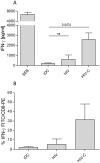Complement as an endogenous adjuvant for dendritic cell-mediated induction of retrovirus-specific CTLs
- PMID: 20442876
- PMCID: PMC2861708
- DOI: 10.1371/journal.ppat.1000891
Complement as an endogenous adjuvant for dendritic cell-mediated induction of retrovirus-specific CTLs
Abstract
Previous studies have demonstrated the involvement of complement (C) in induction of efficient CTL responses against different viral infections, but the exact role of complement in this process has not been determined. We now show that C opsonization of retroviral particles enhances the ability of dendritic cells (DCs) to induce CTL responses both in vitro and in vivo. DCs exposed to C-opsonized HIV in vitro were able to stimulate CTLs to elicit antiviral activity significantly better than non-opsonized HIV. Furthermore, experiments using the Friend virus (FV) mouse model illustrated that the enhancing role of complement on DC-mediated CTL induction also occurred in vivo. Our results indicate that complement serves as natural adjuvant for DC-induced expansion and differentiation of specific CTLs against retroviruses.
Conflict of interest statement
The authors have declared that no competing interests exist.
Figures







Similar articles
-
Antibodies attenuate the capacity of dendritic cells to stimulate HIV-specific cytotoxic T lymphocytes.J Allergy Clin Immunol. 2012 Dec;130(6):1368-74.e2. doi: 10.1016/j.jaci.2012.08.025. Epub 2012 Oct 11. J Allergy Clin Immunol. 2012. PMID: 23063584 Free PMC article.
-
Calreticulin acts as an adjuvant to promote dendritic cell maturation and enhances antigen-specific cytotoxic T lymphocyte responses against non-small cell lung cancer cells.Cell Immunol. 2016 Feb;300:46-53. doi: 10.1016/j.cellimm.2015.12.003. Epub 2015 Dec 14. Cell Immunol. 2016. PMID: 26702740
-
Friend retrovirus infection of myeloid dendritic cells impairs maturation, prolongs contact to naive T cells, and favors expansion of regulatory T cells.Blood. 2007 Dec 1;110(12):3949-58. doi: 10.1182/blood-2007-05-092189. Epub 2007 Aug 15. Blood. 2007. PMID: 17699743
-
Adjuvants Enhancing Cross-Presentation by Dendritic Cells: The Key to More Effective Vaccines?Front Immunol. 2018 Dec 13;9:2874. doi: 10.3389/fimmu.2018.02874. eCollection 2018. Front Immunol. 2018. PMID: 30619259 Free PMC article. Review.
-
Molecular mechanisms and biological significance of CTL avidity.Curr HIV Res. 2003 Jul;1(3):287-94. doi: 10.2174/1570162033485230. Curr HIV Res. 2003. PMID: 15046253 Review.
Cited by
-
Innate Immune Response Against HIV-1.Adv Exp Med Biol. 2021;1313:23-58. doi: 10.1007/978-3-030-67452-6_3. Adv Exp Med Biol. 2021. PMID: 34661890
-
Advances in therapeutic cancer vaccines: Harnessing immune adjuvants for enhanced efficacy and future perspectives.Comput Struct Biotechnol J. 2024 Apr 21;23:1833-1843. doi: 10.1016/j.csbj.2024.04.054. eCollection 2024 Dec. Comput Struct Biotechnol J. 2024. PMID: 38707540 Free PMC article. Review.
-
B Cell Requirement for Robust Regulatory T Cell Responses to Friend Retrovirus Infection.mBio. 2017 Aug 1;8(4):e01122-17. doi: 10.1128/mBio.01122-17. mBio. 2017. PMID: 28765225 Free PMC article.
-
Complement-Opsonized HIV-1 Overcomes Restriction in Dendritic Cells.PLoS Pathog. 2015 Jun 29;11(6):e1005005. doi: 10.1371/journal.ppat.1005005. eCollection 2015 Jun. PLoS Pathog. 2015. PMID: 26121641 Free PMC article.
-
P80 Natural Essence Exerts Efficient Anti-HIV-1- as Well as Adjuvant Effects in DCs.Vaccines (Basel). 2021 Aug 31;9(9):976. doi: 10.3390/vaccines9090976. Vaccines (Basel). 2021. PMID: 34579213 Free PMC article.
References
-
- Pantaleo G, Demarest JF, Soudeyns H, Graziosi C, Denis F, et al. Major expansion of CD8+ T cells with a predominant V beta usage during the primary immune response to HIV. Nature. 1994;370:463–467. - PubMed
-
- McMichael AJ, Rowland-Jones SL. Cellular immune responses to HIV. Nature. 2001;410:980–987. - PubMed
-
- Deeks SG, Walker BD. Human immunodeficiency virus controllers: mechanisms of durable virus control in the absence of antiretroviral therapy. Immunity. 2007;27:406–416. - PubMed
Publication types
MeSH terms
Substances
Grants and funding
LinkOut - more resources
Full Text Sources

